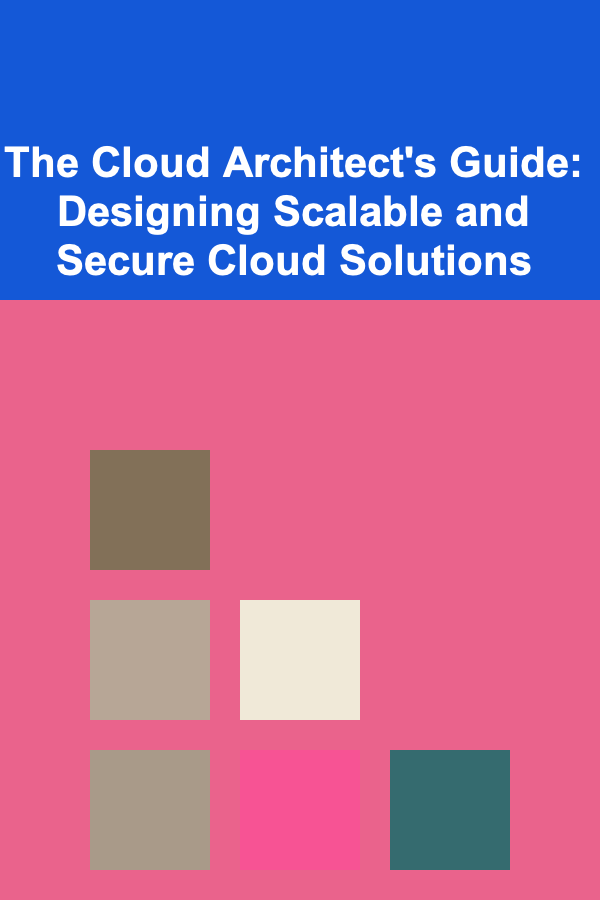
The Cloud Architect's Guide: Designing Scalable and Secure Cloud Solutions
ebook include PDF & Audio bundle (Micro Guide)
$12.99$11.99
Limited Time Offer! Order within the next:

Cloud computing has transformed how businesses operate, offering unparalleled flexibility, scalability, and cost-effectiveness. However, designing cloud solutions that are both scalable and secure requires a strategic approach, involving careful planning, architectural principles, and the right technology choices. As organizations increasingly migrate to the cloud, the role of the cloud architect has become more critical. Cloud architects must not only ensure the seamless performance of cloud systems but also guarantee the integrity and security of data across cloud environments.
In this actionable guide, we'll explore the essential principles, strategies, and best practices for designing scalable and secure cloud solutions. By understanding the critical elements of cloud architecture, from infrastructure design to security measures, you can build cloud systems that are robust, efficient, and prepared for future growth.
Understanding the Core Principles of Cloud Architecture
Scalability
Scalability is a fundamental characteristic of the cloud. The ability to dynamically adjust resources based on demand ensures that cloud solutions can handle spikes in traffic or usage without degrading performance. Scalability comes in two primary forms:
- Vertical Scaling (Scaling Up): This involves adding more resources (CPU, RAM, storage) to an existing server or instance. It's a simpler form of scaling but has physical limits.
- Horizontal Scaling (Scaling Out): Horizontal scaling involves adding more instances or nodes to distribute the load. This is the preferred method in the cloud, as it provides virtually limitless scaling capabilities and better fault tolerance.
High Availability
High availability (HA) refers to the design principles that ensure your system remains operational even if some components fail. Cloud solutions should be designed with redundancy in mind to minimize downtime. Techniques such as multi-zone and multi-region deployments can enhance HA by ensuring that failures in one area don't affect the entire system.
Resiliency
Resiliency in cloud architecture means ensuring the ability of a system to recover quickly from disruptions. This involves designing systems to handle failures gracefully, with automatic failover and disaster recovery mechanisms built in. Resilient systems minimize the impact of outages and maintain continuity of service.
Cost Efficiency
Cost management is crucial in cloud architecture. Cloud services are often billed based on resource usage, so it's essential to design solutions that optimize resource allocation. This includes choosing the right instance types, utilizing serverless computing where appropriate, and using autoscaling to adjust resources based on real-time demand.
Designing for Scalability
Leverage Elasticity
One of the most compelling benefits of cloud computing is elasticity, the ability to automatically scale resources up or down based on current demand. Cloud providers like AWS, Google Cloud, and Azure offer tools like Auto Scaling and Load Balancers that adjust the number of instances based on traffic volume, ensuring that your applications are always running efficiently without unnecessary overhead.
- Auto Scaling: Configure scaling policies that allow cloud resources to automatically increase or decrease based on predefined criteria (e.g., CPU usage, network traffic, etc.). This ensures that applications remain responsive even during traffic spikes.
- Load Balancers: Load balancers distribute incoming network traffic across multiple servers or resources. This helps avoid overloading a single server and ensures that requests are directed to the least busy resources, enhancing application performance.
Decouple Components with Microservices
To build scalable cloud solutions, it's crucial to decouple applications into smaller, manageable components. Microservices architecture allows different parts of your application to scale independently. This approach also increases flexibility by enabling teams to deploy, update, and scale individual services without affecting the entire application.
- Containerization: Use containers like Docker to package applications and services, making it easier to deploy and scale them. Containers are lightweight, portable, and can be orchestrated using tools like Kubernetes to manage their lifecycle.
- Serverless Computing: Serverless platforms (e.g., AWS Lambda, Azure Functions) allow you to run code in response to events without provisioning or managing servers. Serverless solutions scale automatically based on demand, and you pay only for the computing resources used.
Use Distributed Databases
Traditional monolithic databases often become a bottleneck in scaling applications. To achieve scalability, consider using distributed databases like Amazon DynamoDB, Google Cloud Spanner, or Azure Cosmos DB. These databases can scale horizontally across multiple nodes, providing greater availability and performance.
- Sharding: Split data across multiple databases or servers to distribute the load. Sharding allows databases to scale horizontally by creating partitions that are distributed across different systems.
- Replication: Use replication to create copies of your database across multiple servers or regions. This helps with load balancing, increases fault tolerance, and improves read performance.
Designing for Security
Identity and Access Management (IAM)
Effective identity and access management (IAM) is foundational to securing cloud solutions. IAM ensures that only authorized users and services can access resources in the cloud. Implement role-based access control (RBAC) to assign permissions based on the user's role within the organization.
- Least Privilege Principle: Always grant the minimum permissions necessary for users or applications to perform their tasks. This reduces the potential impact of a compromised account or service.
- Multi-Factor Authentication (MFA): Enable MFA to add an additional layer of security to cloud services. Even if a user's password is compromised, MFA ensures that an attacker cannot gain access without the second authentication factor.
Encryption
Encryption protects data at rest, in transit, and during processing. In the cloud, sensitive data should always be encrypted to prevent unauthorized access.
- Data at Rest: Encrypt data stored on cloud storage services (e.g., Amazon S3, Google Cloud Storage). Use cloud provider services such as AWS Key Management Service (KMS) or Azure Key Vault to manage encryption keys.
- Data in Transit: Use Transport Layer Security (TLS) to encrypt data transmitted between users and services, preventing interception and man-in-the-middle attacks.
- End-to-End Encryption: For particularly sensitive data, consider using end-to-end encryption to ensure that data remains encrypted throughout its entire lifecycle.
Network Security
A secure network design is essential for safeguarding cloud environments. Implement Virtual Private Networks (VPNs), Virtual Private Cloud (VPC) networks, and network segmentation to isolate critical resources and prevent unauthorized access.
- Firewalls: Use firewalls to control traffic between different subnets, ensuring that only authorized traffic can access critical systems.
- Network Access Control Lists (NACLs): NACLs help define rules for inbound and outbound traffic to network resources. They act as an additional layer of security, complementing firewalls.
- Zero Trust Architecture: Adopt a Zero Trust security model, where trust is never implicitly granted, and every user and device must be continuously authenticated before gaining access to resources.
Monitoring and Logging
Effective monitoring and logging are key to detecting and responding to security incidents. Implement cloud-native monitoring tools like AWS CloudWatch, Azure Monitor, or Google Cloud Operations Suite to track system health and security events in real-time.
- Centralized Logging: Use centralized logging systems like ELK Stack (Elasticsearch, Logstash, Kibana) or Splunk to aggregate logs from various services. This enables faster identification and resolution of security issues.
- Security Information and Event Management (SIEM): Use SIEM systems to analyze security data, detect potential threats, and trigger automated responses when suspicious activity is detected.
Best Practices for Building Scalable and Secure Cloud Solutions
Adopt a Multi-Cloud or Hybrid Approach
While single-cloud environments are common, many organizations are moving towards multi-cloud or hybrid cloud strategies. A multi-cloud approach helps avoid vendor lock-in, enhances resilience, and allows for optimized performance across different cloud providers.
- Avoid Vendor Lock-In: By using multiple cloud providers, you can mitigate the risks of being dependent on one vendor. Multi-cloud strategies enable flexibility and resilience.
- Hybrid Cloud for Sensitive Data: Some organizations prefer hybrid architectures, where sensitive data remains on-premises or in private clouds, while less sensitive workloads run in public clouds. This provides a balance between scalability, security, and compliance.
Implement Continuous Integration and Continuous Deployment (CI/CD)
A well-established CI/CD pipeline ensures that your cloud infrastructure is continually updated with new features, fixes, and security patches. Automate the deployment of cloud resources using Infrastructure as Code (IaC) tools like Terraform or AWS CloudFormation.
- Automate Testing: Automate security and performance tests as part of your CI/CD pipeline to catch issues before they reach production.
- Infrastructure as Code: Use IaC to define your cloud resources and configurations in code, making it easier to manage, scale, and secure your infrastructure consistently.
Regularly Update and Patch Systems
Keep your cloud resources up-to-date by applying security patches and updates regularly. Outdated software or services are a significant security risk, as they may contain known vulnerabilities.
- Automated Patch Management: Use cloud-native patch management tools to automate the process of updating software and services to the latest versions.
- Vulnerability Scanning: Regularly scan your infrastructure for known vulnerabilities and resolve any issues promptly.
Conclusion
Designing scalable and secure cloud solutions requires a comprehensive understanding of cloud principles, architectural patterns, and security best practices. By leveraging elasticity, automation, and a robust security framework, you can build systems that are both resilient and capable of scaling with your organization's needs. As cloud computing evolves, cloud architects must stay current with new technologies and continuously refine their strategies to meet the demands of growing businesses and evolving security threats. Following the guidelines outlined in this article will ensure that your cloud solutions are not only efficient but also secure and future-proof.
Reading More From Our Other Websites
- [Home Rental Property 101] How to Protect Your Rental Property with Proper Insurance
- [Survival Kit 101] Best Survival Kit for Digital Nomads: Lightweight, Multi‑Purpose Gear for Global Travel
- [Home Cleaning 101] How to Establish a Bathroom Cleaning Routine for a Sparkling Clean Space
- [Home Renovating 101] How to Update Your Home's Exterior with Curb Appeal Enhancements
- [Home Budget 101] How to Organize a Family Budget to Prepare for the Future
- [Personal Finance Management 101] How to Set Up and Maintain an Investment Portfolio
- [Home Family Activity 101] How to Plan a Fun Day at the Farm
- [Personal Care Tips 101] How to Use Hair Oil for Protecting Hair During Swimming
- [Home Holiday Decoration 101] How to Use DIY Ornaments to Add a Personal Touch to Your Tree
- [Organization Tip 101] Affordable Quartz Countertop Repair Solutions for Homeowners

How to Break Down Big Goals into Manageable Tasks with a Checklist
Read More
How to Create a Cozy and Inviting Living Room on a Budget
Read More
How to Soundproof Your Home Office for Maximum Productivity
Read More
How to Create a Compelling Brand Experience
Read More
10 Tips for Editing Corporate Training Materials
Read More10 Tips for Tracking Education Expenses for Tax Purposes
Read MoreOther Products

How to Break Down Big Goals into Manageable Tasks with a Checklist
Read More
How to Create a Cozy and Inviting Living Room on a Budget
Read More
How to Soundproof Your Home Office for Maximum Productivity
Read More
How to Create a Compelling Brand Experience
Read More